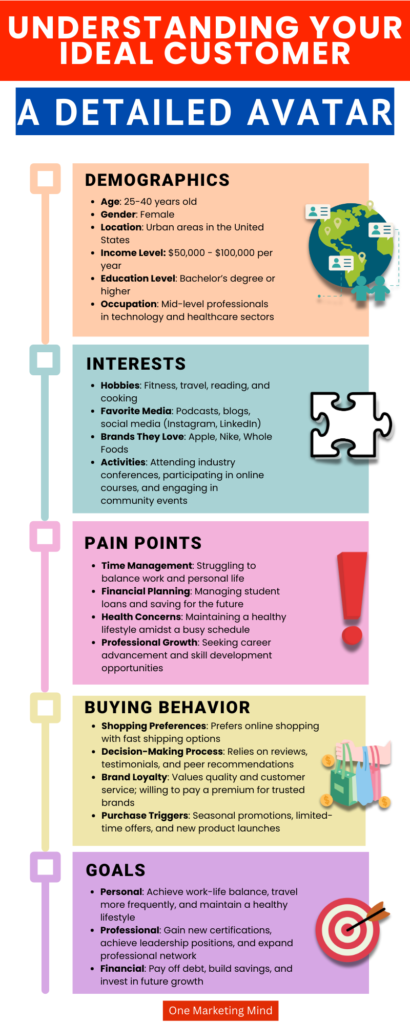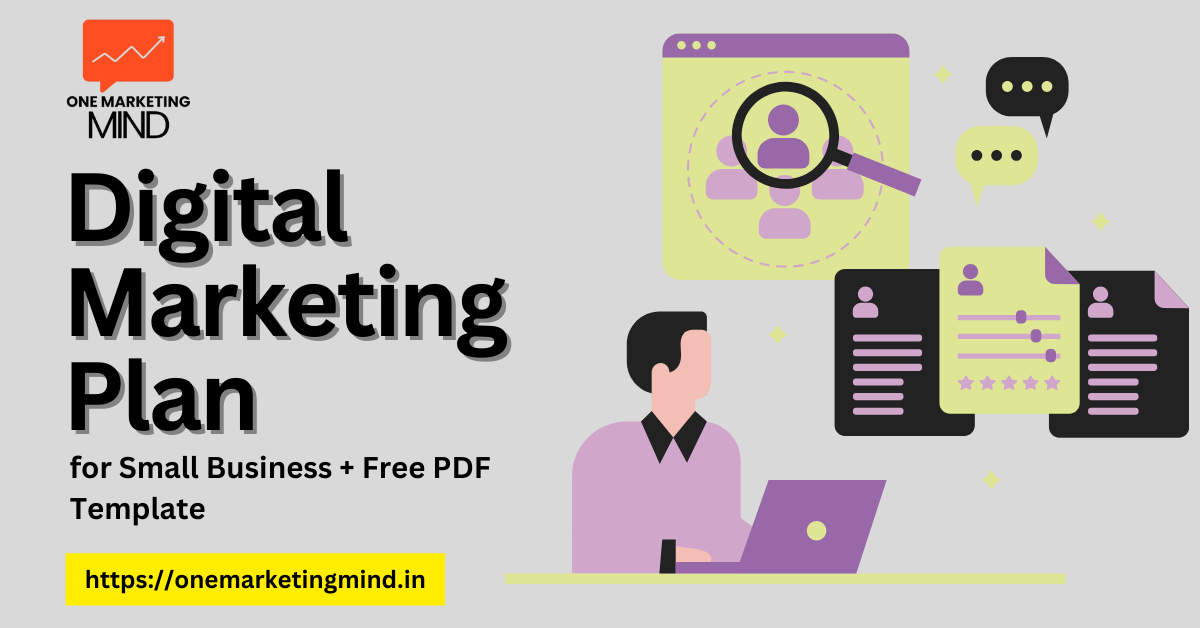In today’s digital age, a robust online presence is crucial for small businesses aiming to compete and thrive. Digital marketing offers unparalleled opportunities to connect with potential customers, build brand awareness, and drive sales. According to recent statistics, 53% of shoppers report that they always conduct research before making a purchase to ensure they are making the best possible choice., making digital marketing an essential tool for small businesses.
This guide provides a comprehensive digital marketing plan tailored for small businesses, helping them enhance their online presence, attract more customers, and increase revenue. So keep reading to learn more about it.
Table of Content
Essential Factors of Perfect Digital Marketing Plan
1. Understanding Your Audience

Importance of Knowing Your Target Audience
Understanding your target audience is the foundation of an effective digital marketing plan. Knowing who your customers are, what they need, and how they behave online allows you to tailor your marketing efforts to meet their expectations.
Techniques to Identify and Understand Your Audience
- Surveys and Questionnaires: Collect direct feedback from your customers to gain insights into their preferences and behaviors.
- Market Research: Analyze industry trends and competitor strategies to understand the market landscape.
- Customer Personas: Create detailed profiles representing your ideal customers, including demographics, interests, and pain points.
2. Setting Goals and Objectives

How to Set SMART Goals
Effective digital marketing goals should be Specific, Measurable, Achievable, Relevant, and Time-bound (SMART). This approach ensures your goals are clear and attainable, guiding your marketing efforts toward tangible outcomes.
Examples of Common Digital Marketing Goals
- Increase website traffic by 25% in six months.
- Generate 50 new leads per month through online marketing channels.
- Achieve a 20% increase in social media engagement over three months.
3. Building an Effective Website

Building a website is crucial for business growth. A strong featured website is gateway for your customer so it can be a must priority thing in digital marketing. Here are some ways to make it user friendly
Key Elements of a User-Friendly Website
- Design: Ensure your website is visually appealing and aligned with your brand identity.
- Navigation: Simplify navigation to help users find information quickly and easily.
- Mobile Responsiveness: Optimize your website for mobile devices to accommodate the growing number of mobile users.
Importance of SEO-Friendly Content and Website Speed
- SEO-Friendly Content: Use relevant keywords naturally throughout your content to improve search engine rankings.
- Website Speed: A fast-loading website enhances user experience and reduces bounce rates, positively impacting SEO.
4. Search Engine Optimization (SEO)

Basic SEO Strategies for Small Businesses
- Keyword Research: Identify and use relevant keywords that your target audience is searching for.
- On-Page SEO: Optimize title tags, meta descriptions, headers, and content for target keywords.
- Off-Page SEO: Build high-quality backlinks to increase your website’s authority.
Importance of Local SEO and Google My Business
- Local SEO: Optimize for local searches by including location-based keywords and creating location-specific content.
- Google My Business: Claim and optimize your Google My Business listing to enhance your visibility in local search results.
Tips for On-Page and Off-Page SEO
- On-Page SEO: Focus on creating high-quality, relevant content that provides value to your audience.
- Off-Page SEO: Engage in link-building activities such as guest blogging and influencer partnerships.
RELATED READ: On-page vs Off-page SEO
5. Content Marketing

Developing a Content Marketing Strategy
Create a strategic plan for your content, outlining what type of content you will produce, how often, and on which platforms.
Types of Content That Engage and Convert
- Blogs: Provide valuable information and insights related to your industry.
- Videos: Create engaging video content that tells your brand story or demonstrates your products.
- Infographics: Use visually appealing infographics to present data and statistics in an easy-to-digest format.
Content Distribution Channels and Repurposing Content
- Social Media: Share your content on social media platforms to reach a broader audience.
- Email Newsletters: Distribute your content through email to engage with your subscribers.
- Repurposing Content: Reuse and adapt existing content for different formats and platforms to maximize its reach.
Related read : Different content writing types and styles used in marketing
6. Social Media Marketing

Choosing the Right Social Media Platforms for Your Business
- Identify the social media platforms where your target audience is most active and focus your efforts there.
Creating a Social Media Calendar and Posting Schedule
- Plan your social media posts in advance with a content calendar to maintain consistency and ensure timely updates.
Engaging with Your Audience and Using Social Media Analytics
- Engagement: Interact with your followers through comments, messages, and live sessions.
- Analytics: Use social media analytics tools to track performance and adjust your strategy accordingly.
7. Email Marketing

Building and Segmenting Your Email List
- List Building: Collect email addresses through website sign-ups, lead magnets, and events.
- Segmentation: Divide your email list into segments based on customer behavior and preferences to send targeted campaigns.
Crafting Effective Email Campaigns
- Newsletters: Provide valuable updates and information to keep your subscribers engaged.
- Promotional Emails: Send targeted promotions and offers to drive sales.
Measuring Email Marketing Success
- Open Rates: Track the percentage of recipients who open your emails.
- Click-Through Rates: Measure the number of clicks on links within your emails.
8. Pay-Per-Click (PPC) Advertising

Basics of PPC Advertising and How It Works
PPC advertising involves paying for ad placements on search engines or social media platforms, where you only pay when someone clicks on your ad.
Setting Up and Managing Google Ads and Social Media Ads
- Google Ads: Create and manage ads on Google Search and Display Network.
- Social Media Ads: Run targeted ads on platforms like Facebook, Instagram, and LinkedIn.
- Budgeting for PPC and Measuring ROI
- Budgeting: Allocate a budget based on your goals and the competitiveness of your keywords.
- Measuring ROI: Track the return on investment by comparing the cost of ads to the revenue generated.
9. Analyzing and Adjusting Your Strategy

Importance of Tracking and Analyzing Digital Marketing Metrics
Regularly monitor your marketing metrics to understand what’s working and what needs improvement.
Tools for Monitoring Performance
- Google Analytics: Track website traffic, user behavior, and conversions.
- Social Media Insights: Analyze engagement, reach, and follower growth on social media platforms.
How to Adjust Your Strategy Based on Data
- Use the insights gained from analytics to refine your strategies and optimize your campaigns for better results.
Strategies for Execution of Digital marketing plan
1. Start With “Who”

Identify Your Ideal Customer
Knowing your ideal customer is the cornerstone of a successful digital marketing plan. This ideal customer, often referred to as your “dream customer,” is the person who will benefit most from your product or service. By understanding their needs, preferences, and behaviors, you can create tailored marketing campaigns that attract and retain these customers effectively.
Example: Imagine a local bakery specializing in gluten-free products. Their dream customer is likely someone with a gluten intolerance, health-conscious individuals, or parents looking for healthy snack options for their kids. By focusing on these specific needs, the bakery can tailor its marketing messages to highlight the health benefits and unique qualities of its gluten-free offerings.
Best Practices:
- Conduct Surveys: Use tools like Google Forms or SurveyMonkey to gather information directly from your audience.
- Analyze Data: Use customer data from your CRM to identify patterns and trends.
- Engage on Social Media: Monitor and participate in discussions to understand your audience’s preferences and pain points.
2. Develop a Detailed Customer Avatar
Creating a detailed customer avatar, or buyer persona, helps you visualize and understand your target audience on a deeper level. This avatar should include demographic details (age, gender, income level), psychographic details (interests, values, lifestyle), and behavioral insights (buying habits, brand loyalty).
Example: For a fitness app, a customer avatar might look like this: Jane, a 28-year-old marketing manager, earns $70,000 a year, values health and wellness, enjoys yoga and running, prefers organic food, and often shops online. She follows fitness influencers on Instagram and reads health blogs.
Best Practices:
- Demographic Data: Collect data on age, gender, income, and education.
- Psychographic Data: Understand interests, values, and lifestyle choices through social media insights and customer interviews.
- Behavioral Data: Track buying habits, product preferences, and brand interactions using analytics tools like Google Analytics.
Check this sample customer avatar infographic for creating digital marketing plan

3. Regular Brainstorming Sessions
Periodic brainstorming sessions with your team can generate new insights into your target audience. These sessions can help identify emerging trends, uncover pain points, and discover new opportunities that can inform your marketing strategies.
Example: A quarterly brainstorming session might reveal that a significant number of your customers are interested in eco-friendly products. This insight can lead to the development of a new line of sustainable products and a marketing campaign focused on environmental benefits.
Best Practices:
- Diverse Participation: Include team members from different departments to get a variety of perspectives.
- Structured Sessions: Use frameworks like SWOT analysis (Strengths, Weaknesses, Opportunities, Threats) to guide discussions.
- Encourage Creativity: Foster an open environment where all ideas are welcomed and considered.
4. Understand Your Funnel
Conversion
Conversion involves turning prospects into paying customers. Understanding your conversion funnel is crucial for identifying and optimizing the steps your audience takes from initial contact to purchase.
Example: For an online clothing store, the conversion funnel might include stages such as discovering the website through social media ads, browsing products, adding items to the cart, and completing the purchase. Each stage should be optimized to reduce friction and enhance the user experience.
Best Practices:
- Clear CTAs: Use clear and compelling calls-to-action to guide users through the funnel.
- A/B Testing: Continuously test different elements of your funnel (e.g., headlines, images, CTAs) to see what performs best.
- Simplify Checkout: Ensure your checkout process is straightforward and user-friendly.
5. Lead Generation
Lead generation focuses on attracting and capturing potential customers’ interest. This involves offering valuable content, resources, or experiences that encourage prospects to provide their contact information.
Example: A software company might offer a free e-book on "10 Tips to Improve Productivity with Our Software" in exchange for an email address. This positions the company as an authority and starts the lead nurturing process.
Best Practices:
- Valuable Offers: Create lead magnets (e-books, whitepapers, webinars) that provide real value.
- Landing Pages: Design optimized landing pages that highlight the benefits of your offer and include a clear sign-up form.
- Follow-Up: Use email automation to follow up with leads and guide them further down the funnel.
6.Traffic
Driving traffic to your website or landing pages is essential for generating leads and conversions. Utilize a mix of digital marketing channels to attract a steady stream of visitors.
Example: A travel agency can use SEO to rank for keywords like "affordable vacation packages," run PPC ads targeting people searching for last-minute deals, and share travel tips on social media to drive traffic to their website.
Best Practices:
- SEO: Optimize your website for relevant keywords to improve organic search rankings.
- Social Media: Share engaging content and interact with your audience to drive traffic from social platforms.
- PPC Advertising: Use targeted ads to reach specific audiences and drive traffic quickly.
7. Turning Leads Into Customers
Front-End Offer
Your front-end offer is the initial product or service presented to new leads, designed to provide immediate value and entice them to make a purchase.
Example: A SaaS company might offer a 14-day free trial of their software, allowing potential customers to experience its benefits firsthand. This trial can lead to a paid subscription if the user finds the software valuable.
Best Practices:
- Low-Risk Offers: Provide low-cost or free trials to reduce the risk for new customers.
- Clear Benefits: Highlight the immediate value and benefits of your offer.
- Easy Access: Ensure the offer is easy to claim and use.
8. Soap Opera Sequence
The Soap Opera Sequence is a series of engaging emails that build anticipation and keep your audience interested. This technique involves creating a storyline that captures the reader’s attention and ends each email with a cliffhanger.
Example: A fitness coach might send a series of emails that share the story of a client’s transformation journey, each email revealing a new aspect of their progress and strategies used, encouraging readers to stay tuned for the next installment.
Best Practices:
- Engaging Stories: Craft compelling narratives that resonate with your audience.
- Cliffhangers: End each email with a teaser or question that encourages the reader to open the next email.
- Consistent Tone: Maintain a consistent and engaging tone throughout the sequence.
9. Seinfeld Emails
Seinfeld Emails are casual, entertaining emails that keep your audience engaged and your brand top-of-mind. These emails can include personal stories, interesting anecdotes, or humorous observations, similar to the style of the Seinfeld TV show.
Example: An online pet store might send a weekly email sharing funny pet stories, tips on pet care, or quirky pet-related news, creating a fun and engaging connection with their subscribers.
Best Practices:
- Relatable Content: Share stories and insights that your audience can relate to.
- Humor: Use humor to entertain and engage your readers.
- Value-Driven: Even casual emails should provide some form of value, whether it’s a tip, a story, or a special offer.
By focusing on understanding your audience, refining your marketing funnel, and implementing engaging strategies, you can create a digital marketing plan for small businesses that effectively turns leads into loyal customers.
Conclusion
In summary, creating an effective digital marketing plan involves understanding your audience, setting clear goals, building a user-friendly website, and leveraging various digital marketing strategies such as SEO, content marketing, social media, email marketing, and PPC advertising. By continuously analyzing and adjusting your strategy based on data, you can enhance your online presence, attract more customers, and increase revenue.
Download our free digital marketing plan template to get started on your journey to digital success. Subscribe to our newsletter for more tips and strategies, or schedule a free consultation to audit your current digital marketing efforts.
This comprehensive template provides actionable insights and practical tips to help small businesses succeed in the digital landscape. By implementing these strategies, small business owners and marketers can create a robust online presence, engage with their target audience, and drive sustainable growth.
Suggested read: Organic marketing strategy and examples

